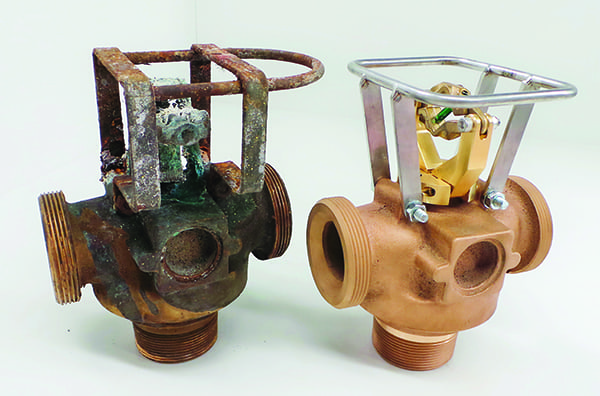Newly Designed Deluge Valve Improves Functionality
Stanwell Power Station, a 1,460-MW coal-fired power plant located in Queensland, Australia, faced a dilemma. The reliability of its fire protection system was questionable. Many of the plant’s multiple jet control (MJC) valves had been in operation since the plant began service in 1996 and the original valve design was considered poor. Valves often leaked, even when new.
The MJC valves are used as an auxiliary deluge valve to control the flow of water to specific areas within larger wet pipe, dry pipe, or deluge systems. They have self-contained heat actuating units that facilitate operation.
An Outdated Design
In Stanwell’s case, some of the time-critical features, such as the heat detection element and the main valve-sealing seat, had experienced corrosion and buildup during years of being in service. Therefore, reliable valve operation, which is critical during a fire, could not be guaranteed. A wholesale replacement of the valves was deemed necessary.
The process wasn’t as simple as changing like-for-like valves, because the original equipment manufacturer (OEM) had stopped making the legacy valve design and didn’t produce an alternative. That meant a new valve had to be designed and manufactured (Figure 5). To certify the new design, mandatory destructive testing was required—a costly process. Adding to the complexity, the changeover to the new-generation system would have to fit into a briefly scheduled maintenance window to minimize plant downtime.
The plant turned to Archer Enterprises, a third-generation privately owned, precision engineering firm with its own Manufacturing Centre of Excellence in New South Wales.
The Engineering Process
“It’s one thing to design and manufacture a part, it’s another to think beyond the project brief and consider the ramifications of having that new part implemented into a work site,” explained Archer’s Managing Director Brad Byrne. Sometimes the answer requires approaching the task from a completely new perspective, and in this case, potentially hundreds of thousands of dollars were saved.
Archer’s four-stage solution involved the following steps:
■ Designing a new stainless steel MJC valve capable of connecting to the incumbent infrastructure
■ Reengineering the valve so that the complete unit didn’t have to be destructively tested and the tested part could easily be replaced
■ Introducing an unorthodox changeover procedure
■ Part marking
Archer was able to overcome all of the challenges by designing a more efficient type of MJC valve manufactured from stainless steel and two types of nickel. The original cage feature was done away with and replaced by an open design. This was done so that the entire unit didn’t have to be destructively tested, and the tested part could easily be replaced.
“In addition to the new design, we developed a changeover method for the power station, which allowed them to systematically install the new valves one after the other, meaning there was no interruption to power generation. We made the right amount of valves in continuous stages to suit their time line,” Byrne said.
Then the group initiated part marking and produced reference materials. “Every part at the power station had a code number or reference number for record keeping. Because we developed the brand new assembly, we were in effect the new OEM. Housekeeping is in our culture, so we determined that in addition to coming up with a valve solution, we should support it with the necessary procedures. As each part was machined, we marked it with a part number for asset management and traceability,” Byrne continued.
“For phased end of life, it is vital that you can always track your parts. We developed a comprehensive methodology, which included part numbering, batch numbering, and serial part numbering. We also generated supporting materials, such as reference guides and specification sheets, which Stanwell added to its preventative maintenance program,” said Byrne.
In the end, new MJC valves were installed within the timeframe allotted and reliable operation of the system was restored. ■
—Craig E. Hingston is founder and director of Your Image Marketing & Media.
